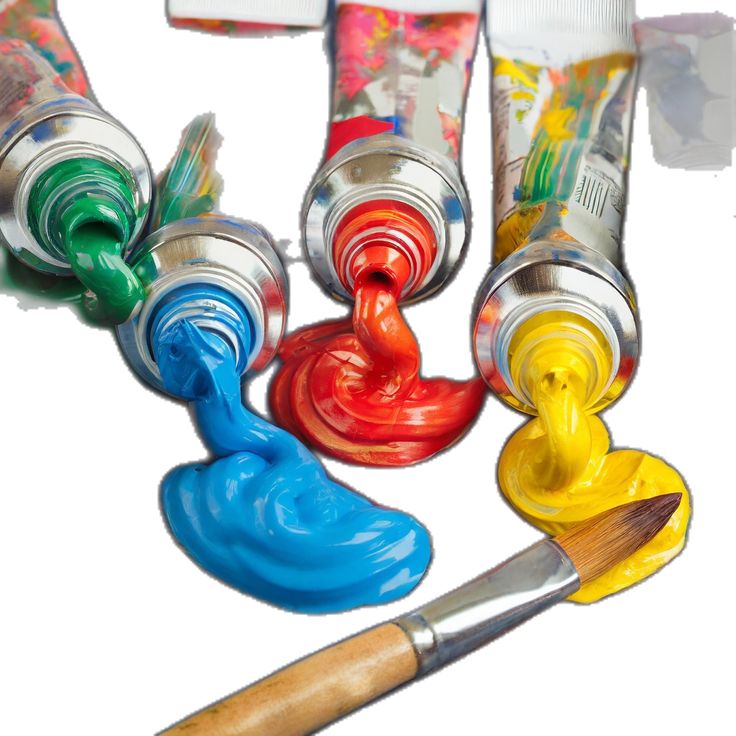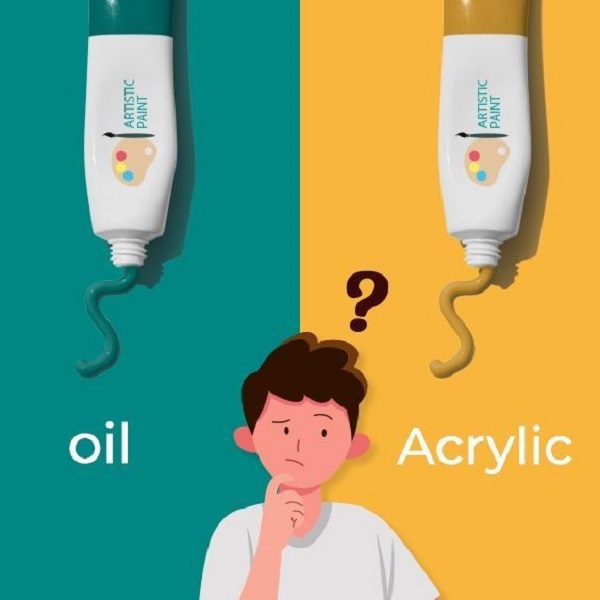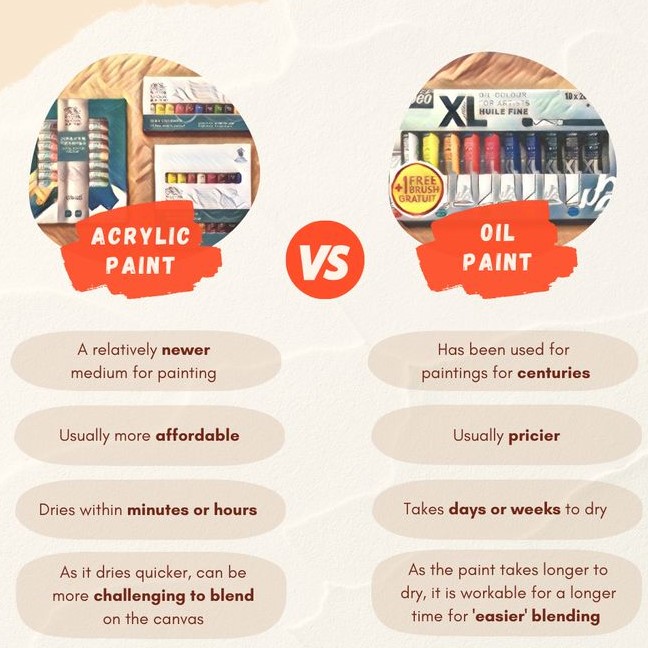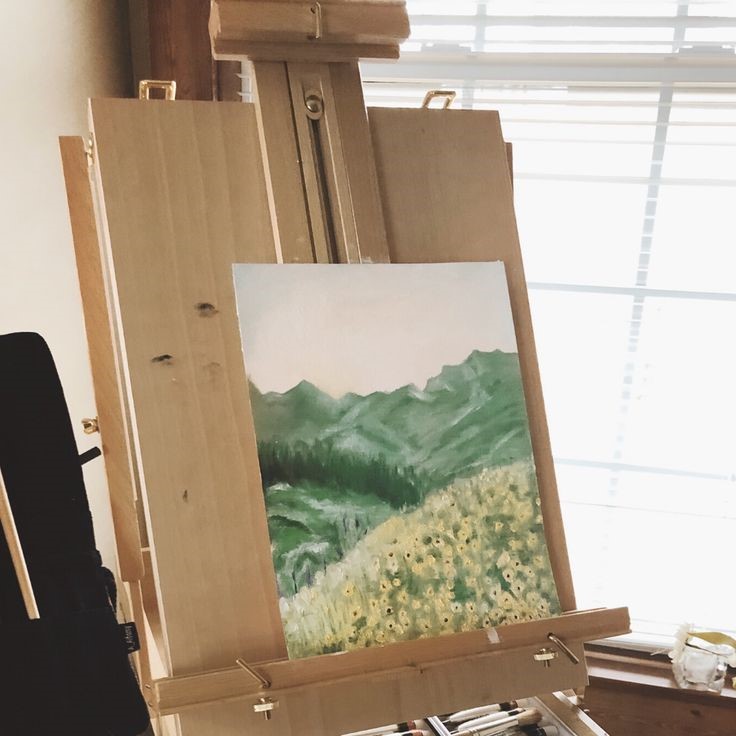Introduction to Acrylic and Oil Paint
Acrylic vs oil paint are popular choices for artists worldwide. Each has unique features and benefits. Acrylic paint is a fast-drying medium made of pigment suspended in acrylic polymer emulsion. Artists use it for its adaptability and quick drying. Oil paint, on the other hand, consists of pigment mixed with drying oils, such as linseed oil. It is valued for its rich texture and longer drying time.
These two paints differ greatly in application and result. Acrylic paint is water-based, while oil paint is oil-based. This difference affects their drying times, finishes, and techniques. Understanding these paints helps artists choose the best medium for their creative needs. Students and professionals alike benefit from knowing how each paint type performs.

In this blog, we will explore acrylic vs oil paint differences. You’ll learn about their properties, drying times, and more. This guide aims to simplify the comparison between the two paint types.
Composition and Properties of Acrylic Paint
Acrylic paint is a water-based medium created from pigment suspended in acrylic polymer emulsion. It is versatile and widely used by artists of all skill levels. The water-based nature makes it easy to thin or clean with water.
Characteristics of Acrylic Paint
Fast Drying
One of the standout characteristics of acrylic paint is its fast drying time. Typically, acrylic paint dries within minutes to a few hours, allowing artists to work efficiently. This quick drying time enables artists to layer their work without enduring long delays between applications. For artists who enjoy building depth and texture through layering, this feature is particularly advantageous.
Additionally, the fast-drying nature of acrylics lets artists correct mistakes and make changes on the fly. If a specific color or stroke doesn’t meet the artist’s expectations, they can quickly paint over it once the layer has dried. This immediacy can improve the overall workflow and creative process, making acrylics a favored medium for many contemporary artists.
Versatility
Acrylic paint is renowned for its versatility, capable of mimicking various techniques and styles. Depending on how they are applied and the mediums mixed with them, acrylics can resemble the delicate washes of watercolor or the rich textures of oil paint.
Artists can employ different techniques such as glazing, impasto, and dry brushing to achieve diverse effects. For instance, by adding water and using a light wash technique, acrylics can produce ethereal, translucent layers akin to watercolors. Conversely, when applied thickly and with less dilution, acrylics can create vibrant, textured surfaces reminiscent of oil paintings. This versatility allows artists significant room for creativity and experimentation, making acrylic paints suitable for a wide range of artistic styles.

Durability
Once dry, acrylic paint forms a strong, water-resistant surface that stands the test of time. This durability not only contributes to the longevity of artworks but also offers resilience against environmental factors. For instance, acrylic paintings are less likely to crack than oil paintings as they age.
Moreover, the water-resistant nature of dried acrylic paint means that artworks can withstand moisture without deteriorating. Because of this property, acrylic paintings can be displayed in various environments without fear of damage from humidity. Additionally, the strong bond that acrylic paint creates with the surface it’s applied to ensures that the artwork remains intact and vibrant for years, even when exposed to light and air.
Wide Range of Colors
Acrylic paint is celebrated for its extensive color palette. It is available in a vast assortment of shades and finishes, catering to all artistic preferences. Whether you seek bright, vibrant colors or muted, earthy tones, you’ll find acrylics that suit your needs.
In addition to a wide range of colors, acrylic paints are offered in various finishes, including matte, gloss, and metallics. The glossy finish provides a shiny effect that enhances color vibrancy, while matte finishes offer a soft, subtle look. Metallic acrylics can introduce an exciting shimmer to artworks, adding depth and interest. This diversity allows artists to explore countless possibilities, enabling them to create unique effects and styles in their projects.
Advantages for Artists
- Ease of Use: Beginners favor acrylic paint for its simplicity and forgiving nature. Mistakes can be easily painted over.
- Adaptability: Artists can use it on various surfaces like canvas, wood, paper, or fabric.
- Non-Toxic and Odorless: Its low toxicity makes it suitable for indoor use without strong odors.
Understanding the properties of acrylic paint is key to using it effectively. Its fast drying time and adaptability make it an excellent choice for creative projects.
Composition and Properties of Oil Paint
Oil paint is a classic medium used by artists for centuries. It consists of pigment mixed with drying oils like linseed or walnut oil. This composition gives it unique properties that make it ideal for certain artistic techniques and styles.
Characteristics of Oil Paint
- Slow Drying: Oil paint dries slowly, giving artists ample time to work and blend colors.
- Rich Texture: The thick, creamy consistency allows for bold brushstrokes and intricate detail.
- Luminous Finish: It creates vibrant, glossy finishes, enhancing the depth of the painting.
- Layering: The slow drying time helps in creating layers that appear smooth and cohesive.
Advantages for Artists
- Extended Working Time: Artists can rework and blend colors over longer periods.
- Vivid Colors: Oil paints retain their color intensity, adding brilliance to the artwork.
- Flexible Application: It can be used on canvas, panels, or other primed surfaces.
- Timeless Durability: Properly preserved oil paintings last for centuries.
Understanding oil paint’s properties helps artists create timeless and vibrant masterpieces. While it requires patience, its results are unmatched in depth and richness.

Drying Time: Acrylic vs Oil Paint
Drying time is a major difference between acrylic and oil paint. It can greatly affect an artist’s workflow and techniques. The choice of paint depends on your preference for either speed or flexibility.
Acrylic Paint Drying Time
- Fast Drying: Acrylic paint dries quickly, often within minutes to a few hours.
- Layering Speed: Artists can apply multiple layers in a single day thanks to its quick drying.
- Adaptability: Its fast drying allows for easier correction or adjustment during the painting process.
- Temperature and Humidity Impact: Higher temperatures or dry conditions can speed up drying further.
Oil Paint Drying Time
- Slow Drying: Oil paint can take days or weeks to fully dry, depending on thickness.
- Workability: The extended drying time enables blending and detailed work over long periods.
- Layering Considerations: Artists must ensure layers dry properly to avoid cracking or smudging.
- Environmental Factors: Humidity and airflow can significantly affect drying time for oil paints.
Key Takeaways
- Efficiency for Quick Artworks: Acrylic’s fast drying makes it ideal for projects with tight timelines.
- Flexibility for Detailed Art: Oil paint’s slow drying suits artists who prefer detailed, blended pieces.
Understanding drying times helps artists decide which paint aligns with their creative needs.
Color Vibrancy and Finish Differences
Color vibrancy and finish are critical factors when comparing acrylic and oil paints. These features affect how an artwork looks and feels, impacting the artist’s creative choices.
Acrylic Paint: Vibrancy and Finish
- Vivid Colors: Acrylic paints offer bright, bold colors that remain consistent after drying.
- Matte or Gloss: They provide options for matte, semi-gloss, or glossy finishes, depending on the medium used.
- Color Shift: Acrylics can darken slightly as they dry, which may require adjustments while painting.
- Layering Flexibility: Quick drying allows multiple layers, affecting how colors interact when blended.
Oil Paint: Vibrancy and Finish
- Rich and Luminous: Oil paints are known for their deep, vibrant hues and glowing finish.
- No Color Shift: Colors in oil paints stay consistent as they dry, ensuring reliability in finished artwork.
- Glossy Appearance: They often have a natural sheen that enhances the painting’s depth and dimension.
- Blending Excellence: Slow drying supports smooth gradient effects and intricate color transitions.
Key Takeaways
- Brightness: Acrylics bring brightness and diverse finish options for modern, crisp artwork.
- Depth: Oils excel in creating depth and natural gloss for classic, timeless styles.
- Artistic Goals: The choice depends on whether you want quick results or detailed, layered projects.
Understanding these differences ensures colors and finishes align with the desired artistic vision.
Versatility and Techniques for Each Paint Type
Understanding the versatility and techniques of acrylic and oil paint is vital for artists. Each medium provides unique ways to explore creativity and adapt to various surfaces and styles.
Acrylic Paint Versatility and Techniques
- Works on Various Surfaces: Acrylic paint adheres to canvas, wood, paper, fabric, and even glass or plastic.
- Water-Responsive: Adding water thins the paint, creating watercolor-like effects.
- Layering Ease: Quick drying allows for rapid layering and adjustments.
- Textural Techniques: Use thick applications or mediums to add texture and dimension.
- Stencils and Masking: Acrylic paints are ideal for using stencils, creating sharp shapes and patterns.
Oil Paint Versatility and Techniques
- Primed Surfaces: Oil paint works best on canvas or wooden panels but requires priming for proper adhesion.
- Layering Slowly: Slow drying time helps achieve smooth gradients and blending effects.
- Impasto Style: Artists use thick, bold brushstrokes for texture and emphasis.
- Glazing: Thin layers of transparent oil paint create depth and luminous effects.
- Wet-on-Wet: Artists blend colors directly on the canvas for soft transitions.
Key Takeaways
- Surface Options: Acrylics adapt to numerous surfaces, while oils excel on primed ones.
- Technique Complexity: Acrylic supports fast adjustments, while oils suit detailed blending.
- Creative Goals: Choose acrylic for flexibility or oil for refined, layered art.
Mastering these techniques will help you unleash the full potential of each paint type.
Durability and Longevity of Paintings
The durability and longevity of a painting depend greatly on the type of paint used. Acrylic and oil paints differ in how well they endure over time and under various conditions. Understanding these differences helps artists preserve their work effectively.

Acrylic Paint: Durability and Longevity
- Strong Surface: When dry, acrylic paint forms a tough and water-resistant surface.
- Environmental Resistance: It withstands humidity, temperature changes, and ultraviolet light without much fading.
- Minimal Cracking: Acrylic paintings rarely crack due to their flexible dried surface.
- Maintenance Ease: Cleaning is simple with water and mild soap, making upkeep less challenging.
Oil Paint: Durability and Longevity
- Timeless Quality: Oil paintings have lasted centuries, showing their incredible durability.
- Vulnerability to Cracking: Improper layering may lead to cracking over time.
- Environmental Sensitivity: Oil paints are more vulnerable to humidity and temperature variations.
- Preservation Needs: They often require varnishing and careful maintenance to prevent decay.
Key Takeaways
- Acrylic Paint Durability: Acrylics excel in resisting environmental changes and maintain flexibility.
- Oil Paint Longevity: Oils provide timeless quality but need proper care for long-lasting results.
- Practical Choice: Choose based on the environmental exposure and maintenance requirements for your painting.
Cost and Accessibility Comparison
Understanding the cost and accessibility of acrylic and oil paints is crucial for artists. These factors influence the feasibility of choosing a medium for various projects.
Acrylic Paint: Cost and Accessibility
- Affordable Price: Acrylic paint is generally cheaper than oil paints. It suits most budgets.
- Wide Availability: You can find acrylic paints in art stores, craft shops, or online. They are easy to source.
- Beginner-Friendly Kits: Many starter kits include multiple colors and brushes, making them convenient for beginners.
- Low Additional Costs: Acrylics don’t require expensive solvents or primers for use or cleaning.
Oil Paint: Cost and Accessibility
- Higher Cost: Oil paints tend to be more expensive due to their premium pigments and materials.
- Limited Starter Kits: Beginner kits are less common and often higher-priced compared to acrylic options.
- Additional Expenses: Oil painting requires solvents, mediums, and primed canvases, increasing overall costs.
- Availability: Oil paints are widely available but may not be stocked in general craft stores.
Key Takeaways
- Budget-Friendly Option: Acrylics provide an affordable entry point for hobbyists and beginners.
- Investment Medium: Oils appeal to professionals seeking premium quality but come at a higher cost.
- Accessibility Matters: Acrylics are easier to find and use for those new to painting.
Conclusion
In conclusion, understanding the acrylic vs oil paint differences is pivotal for artists seeking to elevate their projects to the next level. Each medium has unique characteristics, advantages, and applications, making it essential to consider your personal style, comfort, and project needs when making a decision. Whether you opt for acrylics’ quick-drying versatility or the richness of oil paints, both mediums offer exciting opportunities for creative expression. Explore these paints, experiment with techniques, and find the medium that resonates with you!
